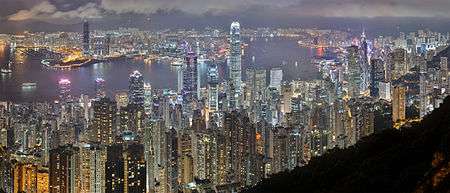Light pollution in Hong Kong

Hong Kong has been named the world's worst city for light pollution. Commercial and residential areas Mong Kok, Tsim Sha Tsui and Causeway Bay are found to be the most severe areas of light pollution. Due to the spotlights and LED billboards, Hong Kong’s sky is many times brighter than other cities’.
Background
The problem of light pollution in Hong Kong became a subject of public concern and debate since 2008.[1] The Hong Kong government set up a "Task Force on External Lighting" to look into the problem in 2011. It conducted two sessions of public consultation, and collected a series of public opinions over three months in 2013.[1]
Separately, the topic also gained academic interest. The Department of Physics at the University of Hong Kong took measurements from a number of locations in Hong Kong and ranked them against a benchmark of "normal dark sky", and found that the highest level of light pollution was the Hong Kong Tsim Sha Tsui was on average 1000 times brighter than the benchmark, and the worst reading in the world.[2][3] Apart from that, a survey by four students from Worcester Polytechnic Institute in Massachusetts discovered that the light of the neon signs from buildings in Causeway Bay was 176 lux bright and Mong Kok was about 150 to 500 lux, which is far higher than British agencies recommend.[4] Even at the Wetland Park in Tin Shui Wai, the brightness was 130 times higher than the International Astronomical Union standard.[3] The rise of complaints also reveals the seriousness of the problem. The number of complaints has increased from 87 in 2007 to 377 in 2009.[5] In brief, the problem of light pollution has not only appeared in commercial areas like Mong Kok and Causeway Bay, but also in the residential areas outside the urban centre. Cheng Sze-ling, environment affairs officer of Friends of the Earth, said “Light pollution is no longer endemic but has evolved into an infectious disease across the city.”[6]
A Symphony of Lights, a show for tourists, has been criticised for contributing to light pollution.
Effects
On neighbourhoods
In some areas of heavily mixed residential developments like Mong Kok and Sham Shui Po, some residents have trouble sleeping as they have to bear strong neon light through their bedroom windows, emitted by the precincts which are lit up like football stadiums.[7]
On human beings
Excessive amounts of light can disrupt the biological clock of humans and affect their brains and hormone function.[3]
On the environment
In the remote Sai Kung countryside, the brightness emitted from the giant LED billboards can affect the breeding of the firefly, an insect relying on light signals to its mate. They will emit their signal less frequently, according to the Hong Kong Entomological Society chairman Yiu Vor. Furthermore, it will affect their continuing survival.[3]
Voluntary guidelines on external lighting
As Hong Kong’s commercial and residential areas are not strictly separated, it is difficult to combat light pollution as no simple regulation rule can be applied to these merged zones. The government currently imposes no laws to regulate excessive lighting. Instead, a Task Force on External Lighting[8] set up by the Environment Bureau has issued the Guidelines on Industry Best Practices for External Lighting Installations.[9] However, it is carried out on a voluntary basis by the industry and is thus criticized as toothless. The lawmakers are still investigating the need to set up specific laws in regulating external lighting. Yet, opinions are divided. While residents generally welcome the idea, the tourism and advertising industries both rely on lighting to boost business.[10] Some opponents to a "lights-out" argue that the beautiful night view is a unique feature of Hong Kong that should not be lost through legislation.
In 2015, the Task Force on External Lighting's recommendation that light pollution in Hong Kong be tackled by a voluntary charter, saying that it found Hong Kong was not yet ready for a legislative solution to the issue, was met with great disappointment from the Legislative Council committee on environmental affairs.[1] The task force recommended a two-year scheme in which merchants will be asked to turn off outdoor lighting voluntary by 11 pm. Committee chairman Kenneth Chan said that the government had obviously given in to pressure from the commercial sector, which was opposed to any curbs on external lighting.[1]
References
- 1 2 3 4 http://www.ejinsight.com/20150423-task-force-suggests-voluntary-scheme-to-curb-light-pollution/
- ↑ http://www.singpao.com/xw/gat/201303/t20130320_424973.html
- 1 2 3 4 Cheung, Chi-fai (20 March 2013). "Light pollution in Hong Kong 'worst on the planet'". South China Morning Post. Retrieved 6 April 2013.
- ↑ Nip, Amy (19 July 2012). "Students shed light on neon, billboard woes". South China Morning Post. Retrieved 6 April 2013.
- ↑ Cheung, Simpson (19 July 2012). "Neighbours see red over 'green' billboard lights". South China Morning Post. Retrieved 6 April 2013.
- ↑ Cheung, Chi-fai (19 July 2012). "Residents struggle with glare as light pollution spreads to Tseung Kwan O". South China Morning Post. Retrieved 6 April 2013.
- ↑ Shadbolt, Peter (21 March 2013). "Hong Kong's light pollution 'worst in the world'". CNN. Retrieved 6 April 2013.
- ↑ "Guidelines on Industry Best Practices for External Lighting Installations issued". Hong Kong Information Service Department. 2012-01-26.
- ↑ "Guidelines on Industry Best Practices for External Lighting Installations" (PDF).
- ↑ Cheung, Chi-fai (2011-03-29). "Lawmakers split on need for law on light pollution". South China Morning Post.